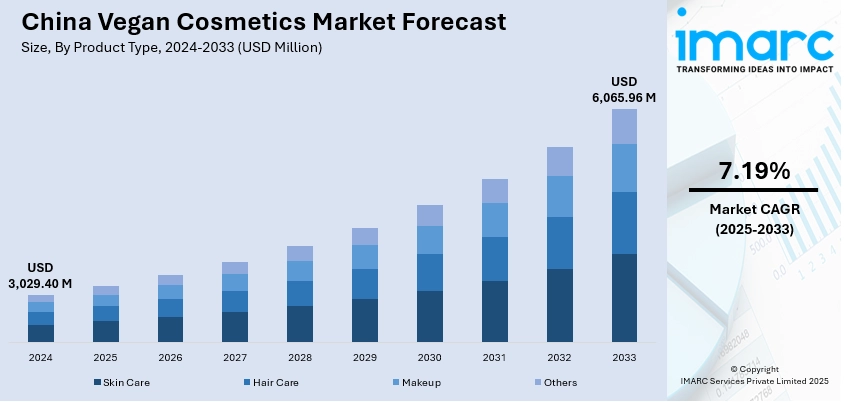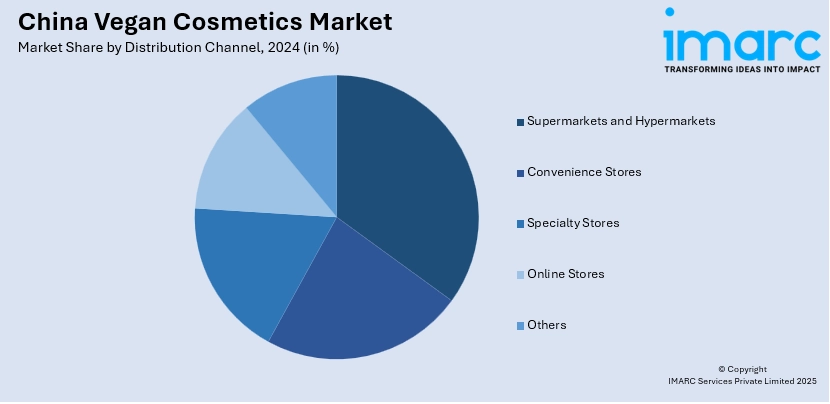
China Vegan Cosmetics Market Size, Share, Trends and Forecast by Product Type, Distribution Channel, and Region, 2025-2033
China Vegan Cosmetics Market Overview:
The China vegan cosmetics market size reached USD 3,029.40 Million in 2024. Looking forward, the market is expected to reach USD 6,065.96 Million by 2033, exhibiting a growth rate (CAGR) of 7.19% during 2025-2033. The market is driven by rising consumer interest in natural and animal-free beauty solutions, eco-awareness, and healthier skin care options. Regulatory push toward prohibiting animal testing in cosmetic imports and clean-label innovations further fuel demand. Eco-packaging and responsible sourcing appeal to Chinese millennials and Gen Z consumers who value sustainability and social responsibility, further fuel the China vegan cosmetics market share.
|
Report Attribute
|
Key Statistics
|
|---|---|
|
Base Year
|
2024
|
|
Forecast Years
|
2025-2033
|
|
Historical Years
|
2019-2024
|
| Market Size in 2024 | USD 3,029.40 Million |
| Market Forecast in 2033 | USD 6,065.96 Million |
| Market Growth Rate 2025-2033 | 7.19% |
China Vegan Cosmetics Market Trends:
Fusion of Traditional Botanical Wisdom with Modern Vegan Formulations
A powerful trend in China's vegan beauty market is the convergence of ancient herbal customs with contemporary plant-based ingredients. Brands are increasingly recalling goji berry extract, lotus root essence, green tea polyphenols, and ginseng which are the ingredients of Traditional Chinese medicine and using them in vegan skincare and beauty products. These plants are deeply linked to the region and strongly resonate with consumers who anticipate clean, natural effectiveness. As international interest in TCM-inspired beauty increases, Chinese brands are formulating veganized versions of traditional serums, masks, and toners that prioritize balanced combinations of plant-based actives and restrained formulations without animal materials. This convergence of cultural heritage and vegan values puts China at the forefront of reimagining historical plant knowledge within a contemporary cruelty-free cosmetics framework.

To get more information on this market, Request Sample
Regulatory Shift toward Cruelty-Free Imports and Domestic Certification
One unique trend defining the market is China's regulatory transformation toward cruelty-free import regulations and increased uptake of vegan certifications. Over the past few years, China has removed or waived animal-testing for imported online cosmetics, paving the way for overseas vegan beauty brands. At the same time, domestic Chinese brands are gaining cruelty-free and vegan certifications that meet international standards. This regulatory climate stimulates both local and global brands to re-formulate products according to vegan standards, such as avoiding animal-derived ingredients like glycerin, collagen, lanolin, and beeswax. Chinese consumers are increasingly being exposed to more certified vegan choices, driving mainstream adoption. The policy momentum and growing confidence in certified cruelty-free products are driving a trend toward more ethical, open-label products, further contributing to the China vegan cosmetics market growth.
Digital Commerce Platforms, Influencer Advocacy, and Ingredient Transparency
Digitalized beauty culture in China is driving a shift toward influencer-driven vegan consciousness and ingredient transparency. Digital commerce platforms such as Tmall, Xiaohongshu, and Douyin (TikTok–China) feature content creators comparing vegan beauty products, revealing ingredient panels, and demonstrating clean-label routines. Influencers frequently highlight toxin-free and plant-based serums, green packaging, and vegan certification badges, cementing trust around ethical consumption. Consumers in major cities such as Shanghai, Beijing, Guangzhou, and Chengdu are particularly responsive, seeking cruelty-free versions of skincare staples like sheet masks, ampoules, and essences. Brands integrate QR codes and traceability features on packaging to show origin of botanicals and manufacturing practices. The combination of high digital literacy, social commerce trends, and ethical-savvy youth drives demand for fully transparent vegan cosmetics. This technology-enabled environment is propelling China's shift to plant-based, cruelty-free cosmetics.
China Vegan Cosmetics Market Segmentation:
IMARC Group provides an analysis of the key trends in each segment of the market, along with forecasts at the country and regional levels for 2025-2033. Our report has categorized the market based on product type and distribution channel.
Product Type Insights:
- Skin Care
- Hair Care
- Makeup
- Others
The report has provided a detailed breakup and analysis of the market based on the product type. This includes skin care, hair care, makeup, and others.
Distribution Channel Insights:

- Supermarkets and Hypermarkets
- Convenience Stores
- Specialty Stores
- Online Stores
- Others
A detailed breakup and analysis of the market based on the distribution channel has also been provided in the report. This includes supermarkets and hypermarkets, convenience stores, specialty stores, online stores, and others.
Regional Insights:
- North China
- East China
- South Central China
- Southwest China
- Northwest China
- Northeast China
The report has also provided a comprehensive analysis of all the major regional markets, which include North China, East China, South Central China, Southwest China, Northwest China, and Northeast China.
Competitive Landscape:
The market research report has also provided a comprehensive analysis of the competitive landscape. Competitive analysis such as market structure, key player positioning, top winning strategies, competitive dashboard, and company evaluation quadrant has been covered in the report. Also, detailed profiles of all major companies have been provided.
China Vegan Cosmetics Market News:
- In February 2024, Evonik partnered with Jland Biotech, a Chinese company, to promote vegan collagen for use in personal care and cosmetics. Through its Venture Capital business, Evonik has invested in Jland Biotech in order to maximize the benefits of a long-lasting, solid partnership. Evonik will be able to provide commercial quantities of collagen for skincare applications, such as moisturizing and anti-aging lotions, thanks to the partnership.
China Vegan Cosmetics Market Report Coverage:
| Report Features | Details |
|---|---|
| Base Year of the Analysis | 2024 |
| Historical Period | 2019-2024 |
| Forecast Period | 2025-2033 |
| Units | Million USD |
| Scope of the Report |
Exploration of Historical Trends and Market Outlook, Industry Catalysts and Challenges, Segment-Wise Historical and Future Market Assessment:
|
| Product Types Covered | Skin Care, Hair Care, Makeup, Others |
| Distribution Channels Covered | Supermarkets and Hypermarkets, Convenience Stores, Specialty Stores, Online Stores, Others |
| Regions Covered | North China, East China, South Central China, Southwest China, Northwest China, Northeast China |
| Customization Scope | 10% Free Customization |
| Post-Sale Analyst Support | 10-12 Weeks |
| Delivery Format | PDF and Excel through Email (We can also provide the editable version of the report in PPT/Word format on special request) |
Key Questions Answered in This Report:
- How has the China vegan cosmetics market performed so far and how will it perform in the coming years?
- What is the breakup of the China vegan cosmetics market on the basis of product type?
- What is the breakup of the China vegan cosmetics market on the basis of distribution channel?
- What is the breakup of the China vegan cosmetics market on the basis of region?
- What are the various stages in the value chain of the China vegan cosmetics market?
- What are the key driving factors and challenges in the China vegan cosmetics market?
- What is the structure of the China vegan cosmetics market and who are the key players?
- What is the degree of competition in the China vegan cosmetics market?
Key Benefits for Stakeholders:
- IMARC’s industry report offers a comprehensive quantitative analysis of various market segments, historical and current market trends, market forecasts, and dynamics of the China vegan cosmetics market from 2019-2033.
- The research report provides the latest information on the market drivers, challenges, and opportunities in the China vegan cosmetics market.
- Porter's five forces analysis assist stakeholders in assessing the impact of new entrants, competitive rivalry, supplier power, buyer power, and the threat of substitution. It helps stakeholders to analyze the level of competition within the China vegan cosmetics industry and its attractiveness.
- Competitive landscape allows stakeholders to understand their competitive environment and provides an insight into the current positions of key players in the market.
Need more help?
- Speak to our experienced analysts for insights on the current market scenarios.
- Include additional segments and countries to customize the report as per your requirement.
- Gain an unparalleled competitive advantage in your domain by understanding how to utilize the report and positively impacting your operations and revenue.
- For further assistance, please connect with our analysts.
 Request Customization
Request Customization
 Speak to an Analyst
Speak to an Analyst
 Request Brochure
Request Brochure
 Inquire Before Buying
Inquire Before Buying




.webp)




.webp)












